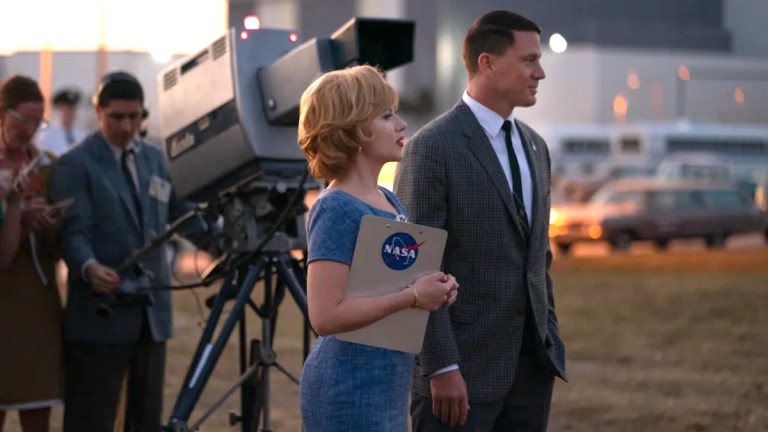How Fly Me to the Moon Attempts to Handle Danger of the Moon Landing Conspiracy Theory
Fly Me to the Moon plays with fire via its riff on NASA supposedly faking the moon landing. But the movie is shrewdly determined to have its conspiracy theory cake and eat it too.

This article contains Fly Me to the Moon spoilers.
It’s a breathtaking shot. More than 50 years after the world watched Neil Armstrong take his one small step for man, and his one giant leap for all mankind, we now see those steps toward the lunar surface from Armstrong’s point-of-view. As the door to the Apollo 11 capsule opens, it is from the astronauts’ perspective we glimpse the fresh, unvarnished moon rock awaiting human footprints.
If this image felt faintly familiar while watching Greg Berlanti’s Fly Me to the Moon, a fusion of the an old school ‘90s romantic comedy with the slipperiness of a conspiracy thriller laugher of the same era, that’s because it’s more or less the same shot in Damien Chazelle’s First Man, an underrated Armstrong biopic that waits until this exact moment to change the film stock and camera lens to true IMAX. It was a bold moviemaking moment there, and it’s bold again in its own subversive way in Fly Me to the Moon. Because here our Armstrong’s gaze keeps looking ever upward—away from the “moon” dust and straight on into the staircase of a mostly barren soundstage tucked away in southern Florida.
Thanks to what is by many standards the most conventional of Hollywood comedies, we are finally given a disquieting visualization of conspiracy theorists and crackpots’ holy grail: proof that the moon landing was faked by Hollywood filmmakers because the American government was terrified of losing the space race to the Soviet Union.
And in the climactic moments of Fly Me to the Moon, we get an idea of what that could’ve been like—even as it’s presented as farce with Jim Rash’s eccentric director called the “Stanley Kubrick of commercials” as he commands his “Armstrong” and “Aldrin” actors like a despot. While the idea of faking the moon landing is obviously a source of comedy in Fly Me to the Moon—a setup slowly teased out by the movie in a wink, wink, nudge, nudge fashion as unwilling NASA publicist Kelly Jones (Scarlett Johansson) gasps “you want to fake it?”—there is no denying the movie is playing with fire.
Belief that the moon landing was staged by NASA was once a fringe idea which only gained traction with contrarians who enjoy a good conspiracy theory in 1976—that is when Bill Kaysing self-published a misleading pamphlet titled “We Never Went to the Moon: America’s Thirty Billion Dollar Swindle.” But the times they are a-changin’. In 2000, 28 percent of Russians polled said they believe the U.S. staged the moon landing; in 2019, 16 percent of British citizens said it was at least probably faked; and even C-SPAN found on the 50th anniversary of the event that while only six percent of Americans believed the moon landing was government propaganda, that statistic is growing with each successive generation. Apparently 11 percent of millennials believe it was staged.
Conspiratorial thinking toward the moon landing is not-so-surprisingly on the rise in a century defined by the embrace of “alternative facts” and folks getting more and more of their “news” from strangers on social media. And yes, it is an “alternative fact” (read: lie) to believe the moon landing was fake since there is irrefutable confirmation of evidence, and not just from the memories and paperwork left by 400,000 Americans who contributed to the herculean project. There is also the 382kg of moon dust NASA has brought back, satellite imaging of the footprints, and independently verified confirmation by the Japanese, Chinese, and even Russian governments that the site exists.
Yet in an age where ever more Americans are willing to trust in a demagogue who will lie about anything—even denying he ever said “you had very fine people on both sides” of the Charlottesville neo-Confederate/Nazi sympathizer rally in 2017 despite him being on video saying exactly that—it is perhaps inevitable that a growing number of folks would deny their own eyes, ears, and basic common sense.
All of which is to say, Fly Me to the Moon might be smirking at the audience by playing with this loaded gun. But is a Hollywood movie really going to add fuel to the fire? Well…
How Fly Me to the Moon Has Its Fake Moon Cake and Eats It Too
In the end, Fly Me to the Moon doesn’t suggest the moon landing was successfully faked. Nor does it even suggest the footage we all know is a fabrication. However, it does suggest the American government tried to do exactly that.
In the film’s Olympic levels of contortions, we learn that while NASA really is attempting to land Apollo 11 on the moon, a shady Mr. Fix-It for the Nixon administration (Woody Harrelson) forces Johansson’s con-woman-turned-NASA publicist into staging a fake moon landing on a soundstage at Cape Kennedy. Initially, this is to only be used if “something” vaguely goes wrong on the mission. However, as the fateful day grows closer, Johansson’s Kelly is ordered to use the soundstage no matter what happens—to the point where the plan is to illicitly pipe in the audio of the real Armstrong moonwalk while replicating it almost gesture-by-gesture on the soundstage with actors.
It should be noted this is executed entirely behind the backs of Armstrong, Aldrin, and all major NASA personnel, including Channing Tatum’s Cole Davis (a thinly fictionalized version of Deke Slayton). Hence the movie’s third act rom-com conflict after Cole finds out Kelly is using her silver-tongued duplicity to turn NASA into conspiratorial liars.
Fortunately, the big twist of the movie is the moon landing—at least seen on television and remembered in the history books—is not faked. Instead Kelly, Cole, and a few other NASA personnel conspire to sabotage the equipment designed to only broadcast the fake moon landing on live television. And through some narrative contrivances, the characters become unsure of which footage is playing on TV screens and which is real. Luckily, they get their answer after the fake moon landing devolves into disaster because a black cat running around Cape Kennedy wanders onto the soundstage and manages to run into the camera frame and beneath the legs of “Armstrong.” Yet when all the characters, including a fuming Nixon button man played by Harrelson, realize the cat isn’t on television, they and the audience can be relieved to know that the moon landing immortalized in history books is the real deal.
Thus Fly Me to the Moon is able to indulge in the popular moon landing conspiracy theory while also “debunking” it in a film that is visibly intended to be a love letter to NASA and the space program.
To be honest though, we found the execution leaves something to be desired. While a comedic and lighthearted rendering of the Apollo program makes for a frothy opening 60 minutes, trying to weave that workplace sitcom setup into a conspiracy theory satire reminiscent of Barry Levinson’s Wag the Dog (another ‘90s throwback), as well as a rather flat rom-com pairing between Johansson and Tatum, ends up knotted and uneven. A mirthful spin on the rah-rah-rah patriotism of The Right Stuff, or the brooding dourness of First Man, is welcome after five decades of reverence paid to the Apollo mission. And Fly Me to the Moon finds a playful way to still tip its hat… but only after dropping it on a floor covered in (fake moon) dust.
The movie is also aware of the dangerous idea it’s playing with in a century where misinformation and delusion run rampant in our online lives. Yet while it walks a delicate tightrope from one side to the other, the sight is more strained and awkward than amusing. It might stick the landing, but that doesn’t mean there aren’t moments where it looked lost in space.
Fly Me to the Moon is in theaters now.

